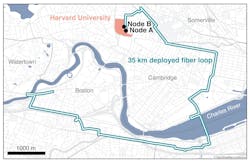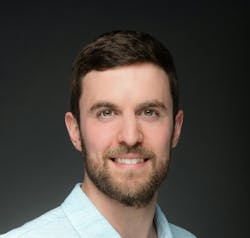Physicists demo network of nanophotonic quantum memory nodes atop telecom fiber
During the past few years, the team has leased optical fiber within the Boston metro area to run their demonstration network atop existing fiber to explore whether creating a quantum internet is possible via this setup.
Quantum memories are central to interconnecting quantum computers because it enables complex network operations and information storage/retrieval.
For their demo, the team uses a photon-mediated entanglement approach—since light is already entangled with the first node, it can be transferred to the second node.
The team’s work shows quantum network nodes can indeed be entangled—even within a busy urban area—and moves us one big step closer to a future quantum internet (see video).
Laser Focus World: What inspired your quantum network node project and how did you pull it off?
Can Knaut: Our quantum network project was inspired by the potential applications of quantum networks, such as quantum-secured communication, distributed quantum computing, and nonlocal sensing protocols. These applications require entangling spatially separated qubits and storing that entanglement for extended periods—a challenging task due to the short-lived nature of quantum information.
Our recent progress in optimizing a two-qubit quantum memory node (basically a small quantum computer), which efficiently interfaces with light, motivated us to pursue our latest experiment.
We used two quantum network nodes to generate and store entanglement between qubits for up to one second. Importantly, we performed entangling operations via a lossy 35-km long deployed fiber link across Boston, which demonstrates our platform is compatible with existing fiber technology and can scale to larger quantum networks.
LFW: Can you describe the basic quantum optics/photonics involved?
Knaut: The quantum system we use is the silicon-vacancy center (SiV) in diamond, a type of color center with an impurity atom (silicon) within the diamond lattice. This structure forms energy levels for a single electron, analogous to those within a single atom. The electron spin interacts with incoming light, facilitating entanglement distribution. An additional nuclear spin is used to store quantum information for extended periods.
To enhance the interaction between light and the electron spin, we place SiVs in nanophotonic optical cavities, confining light tightly around the SiV and increasing the interaction. These cavities—made from high-purity diamond through nanofabrication—are efficiently coupled with a tapered fiber to create a cavity-quantum electrodynamics (cavity-QED) system linked to a single-mode fiber.
LFW: Any cool design work involved?
Knaut: Designing the nanophotonic devices requires a stack of simulation and validation tools that allow the generation of design files that are used in nanofabrication. Besides the nanophotonics device, we also integrate coplanar gold waveguides used for quantum control of the SiV. These waveguides need to be precisely aligned with the location of the SiVs.
LFW: Main thing you’d like people to know about your work?
Knaut: Our work focuses on entangling two small quantum computers over a long, deployed fiber link. Unlike fibers within a controlled laboratory environment, deployed fibers are subject to polarization and phase noise caused by the environment. These noise sources can significantly affect the fidelity of quantum states encoded in the light traveling through these fibers.
To address this, we used a serial entanglement technique enabled by nanophotonic cavities. This method allows us to implement an entanglement protocol that doesn’t require complex phase locking. As a result, we were able to generate entanglement over record in-fiber distances—all while operating in a busy metropolitan area.
The main benefits of our work include demonstrating the feasibility of long-distance quantum entanglement in real-world conditions and paving the way for more robust and scalable quantum networks.
LFW: Coolest aspects of this project?
Knaut: We generated entanglement over a deployed fiber, which resulted in very nontrivial fiber routing. Specifically, the 35-km-long fiber used for entanglement generation crosses the Charles River a total of six times and runs through four municipalities!
LFW: Any challenges to overcome?
Knaut: One major challenge is the synchronization of the experiment. This experiment required extremely precise synchronization of the quantum and classical control signals, with a precision of up to a few nanoseconds, despite the tens of kilometers of fiber distance between the nodes.
Beyond this, working with deployed fiber links introduces polarization drifts, which needed to be automatically compensated for during the experiment.
Another significant challenge was the bidirectional quantum frequency conversion (QFC) of the photonic qubits to the telecom-O band. Integrating QFC into the entanglement generation experiment without significant signal loss necessitated careful component selection and fine-tuning of the experiment.
LFW: Applications?
Knaut: Our quantum networks potentially have applications ranging from quantum-secured communication over distributed quantum computing to distributed quantum sensing protocols.
LFW: What’s next?
Knaut: We’re currently working to extend the performance of our network by adding nodes and experimenting with more networking protocols.
FURTHER READING
C. M. Knaut et al., Nature, 629, 573–578 (2024); https://doi.org/10.1038/s41586-024-07252-z.
P. J. Stas et al., Science, 378, 6619, 557–560 (Nov. 3, 2022); www.science.org/doi/full/10.1126/science.add9771.
About the Author
Sally Cole Johnson
Editor in Chief
Sally Cole Johnson, Laser Focus World’s editor in chief, is a science and technology journalist who specializes in physics and semiconductors.


